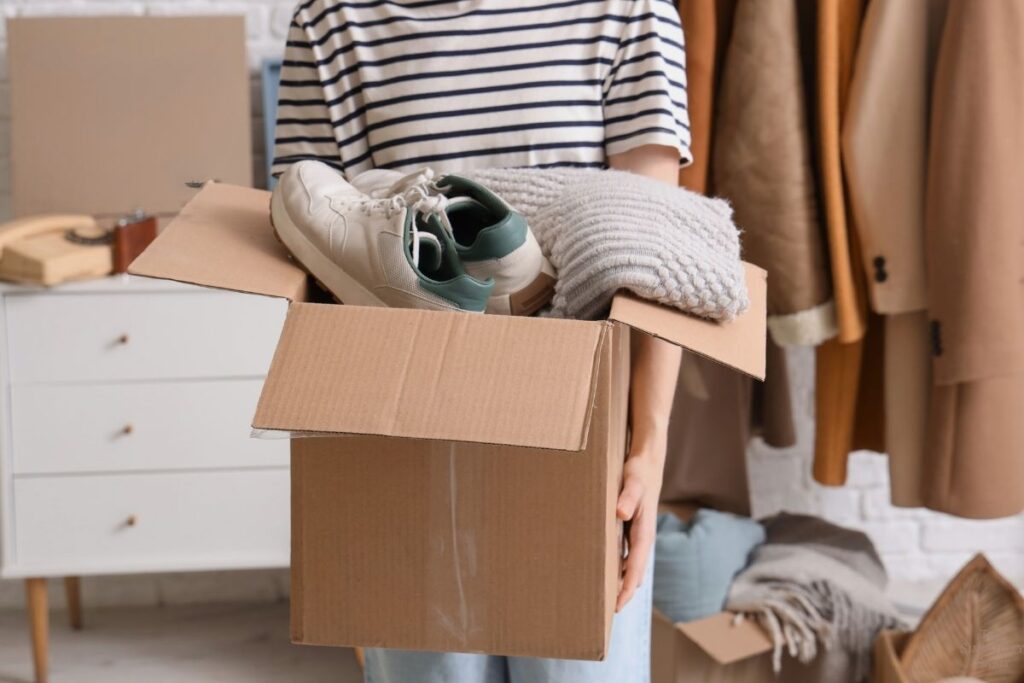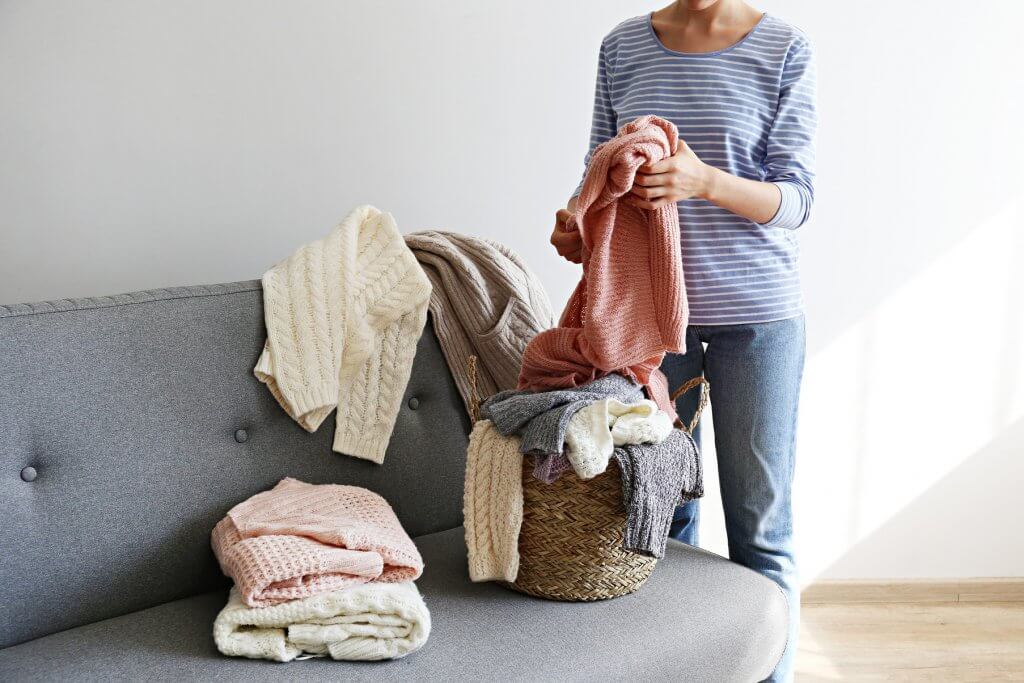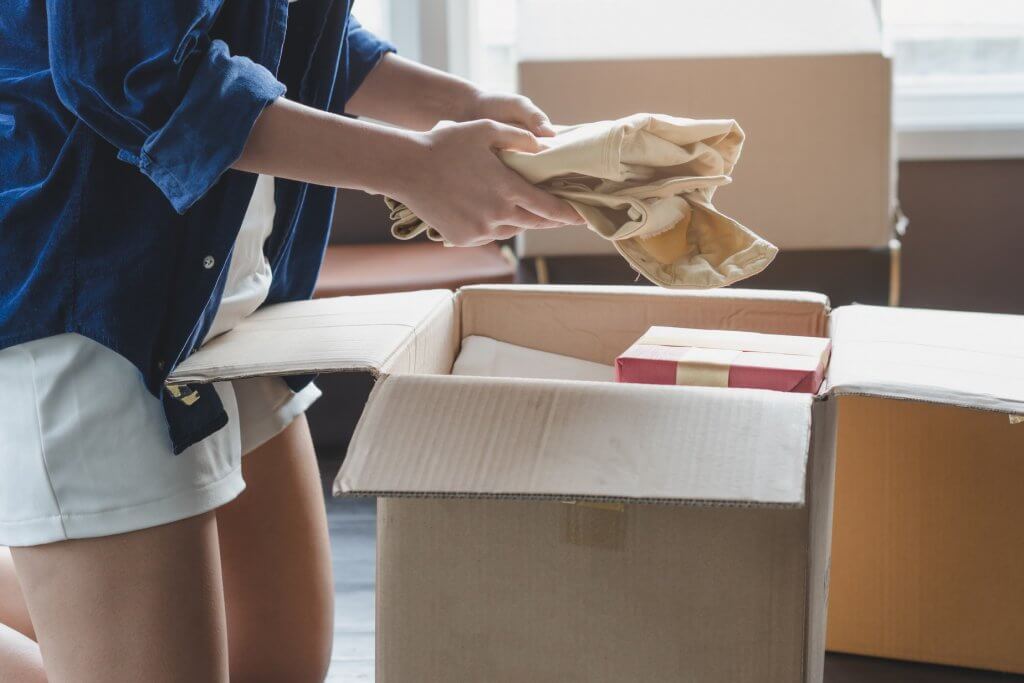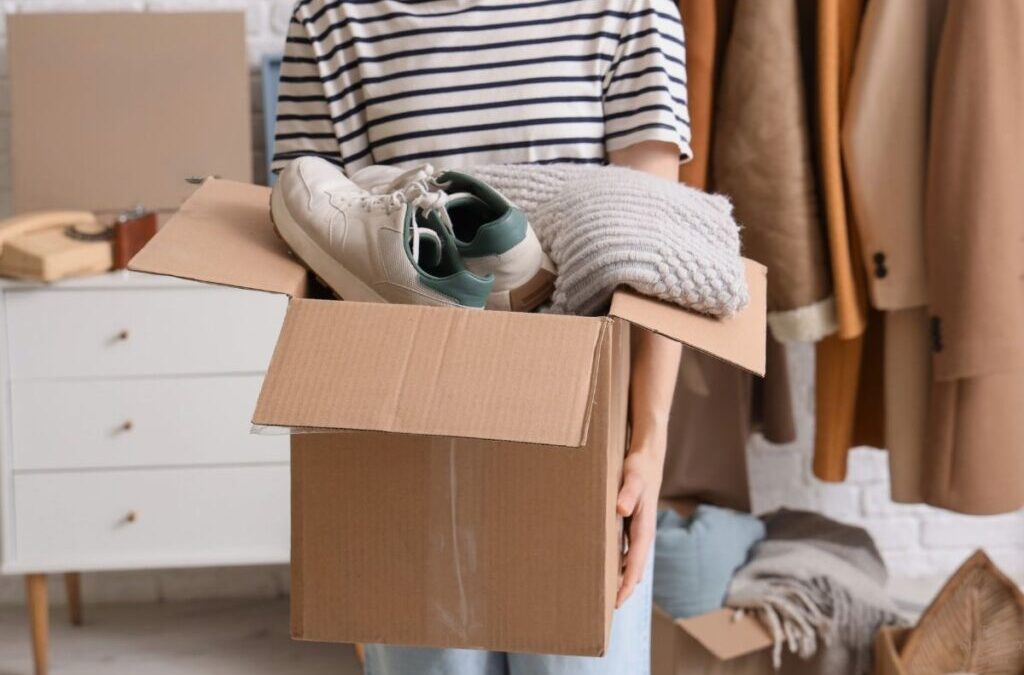Inside: Learn what the no-contact decluttering approach is and how you can use it in your home.
A guest post by Evelyn Long
The rise of minimalism has sparked decluttering trends, such as the KonMari Method or the one-in, one-out rule.
Discarding unneeded belongings can help you create a more organized space and a sense of calm.
Despite the benefits of decluttering, many hesitate to donate items out of worry or fear that they might need or miss them later.
How can you determine what your family truly uses and get rid of the rest? No-contact decluttering may be the answer.

What Is No-Contact Decluttering?
No-contact decluttering is a method of grouping and storing items you want to eliminate for a set period.
Tucking them away lets you see if you would miss them if they were gone. It removes the pressure of an immediate decision so you can take a more methodical approach to tidying your home.
This gentler method can apply to any belongings, like apparel, children’s toys, decorations, and kitchen gadgets.
Here are the core steps of no-contact decluttering:
- Identify items that you may want to donate, sell, discard, or rehome.
- Place them in a box or other storage container that can be kept out of sight, like in a closet or garage.
- Decide on a time frame, such as a few weeks or a month, to keep the box and avoid thinking about the items in the meantime.
- Once the time is up, revisit the box to reevaluate which items you missed and which ones you could live without.
- Part with the things you forgot about while they were in temporary storage.

The Science of No-Contact Decluttering
You aren’t alone if you’ve ever felt so overwhelmed by your items that you didn’t even know where to begin.
Decision fatigue is a common obstacle during the decluttering process. The four main symptoms include procrastination, impulsivity, avoidance, and indecision.
No-contact decluttering gives you space away from your belongings before you need to decide what to do.
This method also helps people with emotional attachments to items declutter their spaces. Your belongings may have sentimental value, making them difficult to part with even if they no longer serve their purpose.
The no-contact decluttering method allows you to identify which items you truly miss.
Successful no-contact decluttering and tidying spaces can have mental health benefits. Clutter is a major cause of stress for over half of Americans, so eliminating things can promote positivity and focus.
Fewer physical distractions can provide a sense of control and allow your mind to think more creatively. Temporarily boxing up unneeded items can encourage you to get rid of them permanently.

7 Things to Know Before Trying No-Contact Decluttering
This slow approach to decluttering can work for busy families and individuals, whether they are downsizing for a move or regaining control over a messy space.
Here are additional considerations before you get started.
1. It’s Not One-Size-Fits-All
The no-contact decluttering method can be adjusted to suit diverse family dynamics and individual requirements. It can be more difficult to part with items that someone in the household has an emotional attachment to.
This system allows you to decide how many possessions you want to temporarily store, how long to keep them, and where they’ll go when the time is up.
2. It Reduces Emotional Burnout
This approach is associated with less emotional labor compared to traditional methods. No-contact decluttering is a trial run to assess your comfort level without having certain items out in the open.
Commitments don’t need to be made immediately, which can soothe decision fatigue.

3. It Saves Time but Requires Planning
No-contact decluttering can fit into a busy schedule since it takes time to decide to donate and then actually do it.
However, there is a little bit of planning involved — without a time limit, your box of items, even if kept out of sight, can begin to feel like clutter.
You must follow through with reevaluating the items and only hold on to what you truly need.
4. It Involves All Family Members
Household collaboration can improve the decluttering process. You should approach no-contact decluttering with a positive mindset to get your partner or children on board.
You might explain why you want to tidy up or suggest specific areas and categories the family should focus on, such as sports equipment.
5. It Clarifies That Organized Clutter Is Still Clutter
It’s best to declutter your belongings before reorganizing them, which involves removing items that are no longer useful.
Organizing is the process of arranging things in a convenient location for future use.

6. It Has Potential Downsides
Like any decluttering approach, complications can still occur. Family members may disagree on what should be put into no-contact storage or what can be donated once the time is up.
They may not want to let something go. It’s common to view belongings as part of your extended self, making you more likely to anthropomorphize objects if you have an anxious attachment style.
You might also discover that you have a legitimate use for or simply miss an item after it’s gone. No one wants to experience decluttering regret.
7. It Sometimes Requires Outside Help
You may need outside support if decluttering overwhelms your household. Trusted friends or family members can help you sort through items if you feel torn about whether you need them.
It may be wise to seek professional assistance for severe clutter or hoarding that poses a risk to health or safety.

Best Practices for No-Contact Decluttering
No-contact decluttering can help families confidently get rid of unneeded belongings, and the process can be seamless and rewarding.
Here are specific tips to help you begin:
- Break it down by decluttering certain rooms at a time rather than tackling everything all at once.
- Encourage family members to start small with seasonal or seldom-used objects. This can help them gain momentum and confidence when sorting through their items.
- Label any boxes or bins used for no-contact decluttering so they don’t get lost or mixed up with other storage containers.
- Set a reminder or mark your calendar for when to revisit the box so it’s not forgotten about.
- Plan exactly what you want to do with the items after the period is up. This may include researching donation centers in your area or getting familiar with digital marketplaces.
Do you feel obligated to hold on to items, perhaps because of the memories or people associated with them?
If you’re keeping something only because it was significant to someone else in the family, it may be time to let it go. Memories are of the people, whereas things are just things.

Is No-Contact Decluttering Right for You?
No-contact decluttering can help your family determine what you actually need before getting rid of things. It can prevent a sense of urgency or pressure, easing you into a calm organizational mindset. Test out this slow, gentle method to see if it’s the solution your family has been looking for.

Evelyn Long is a home organization writer who helps homeowners and renters maintain a neat space through innovative decluttering tips. She has written for several other publications, including the National Association of Realtors and DecorMatters. She is also the editor-in-chief of Renovated Magazine, where she shares additional tips on decluttering and home organization.
Have you tried the no-contact decluttering method? Let us know how it worked for you in the comments section below.
Sign up on the form below to get weekly decluttering tips and inspiration sent straight to your inbox. You’ll also get the free 5 Areas to Declutter in 10 Minutes Checklist to help you get started decluttering today.

